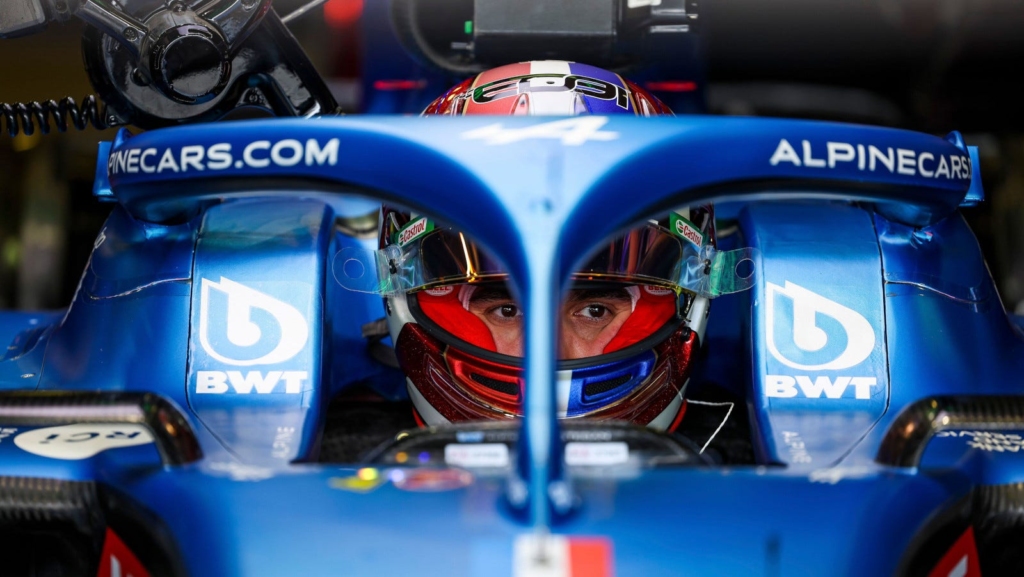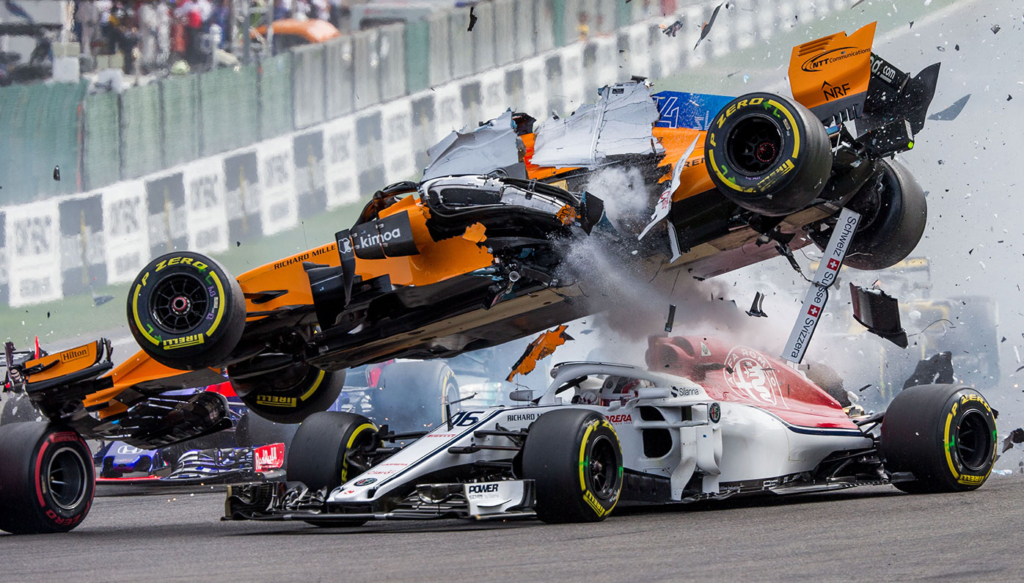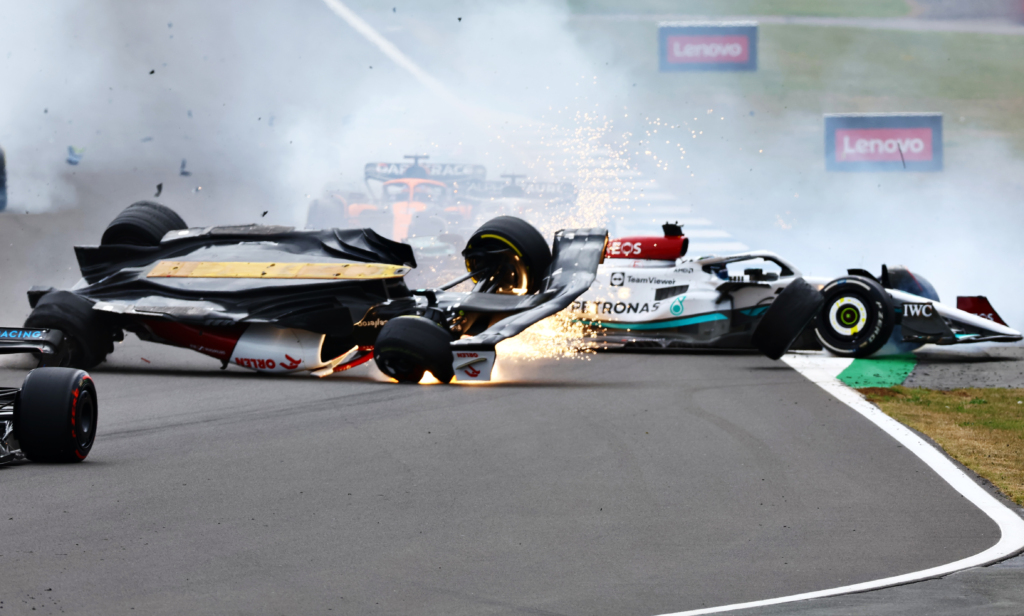Definition and Function of HALO
The HALO (Head Protection Area) is a curved titanium bar placed around the driver’s cockpit to protect their head in the event of debris impacts and crashes in Formula 1 racing. The upgrade to driver’s safety has been introduced in 2018. So exactly, how halo works? It creates a protective space around the driver’s head and deflects or absorbs energy from impacts, therefore reducing the risk of serious injury or death from objects penetrating the cockpit area.
The Historical Development of HALO
The concept for cockpit protection bars first emerged in the late 2000s within the FIA Institute for Motor Sport Safety. Research indicated that debris and objects striking a driver’s head were among the most life-threatening crashes in open-cockpit racing cars. Various prototypes were tested over the next few years, with the final HALO design settled on by 2015 for introduction in F1 by 2018. The development process involved extensive computer simulation and physical testing to ensure structural integrity while preserving cockpit ergonomics and driver visibility.
Official Introduction of HALO in Formula 1
After extensive testing and evaluation, the FIA made the HALO device mandatory for all Formula 1 cars starting with the 2018 championship season. This marked the first major cockpit protection device to be introduced in the sport since the adoption of full-face helmets in the 1970s. Most teams incorporated the HALO bars around existing monocoque chassis designs for 2018, although some teams like Ferrari integrated the mountings into redesigned chassis.

The Impact of HALO on Safety and its Durability
How HALO works and enhances Driver Safety
HALO enhances driver safety in Formula 1 in several key ways:
- It deflects or absorbs the impact of objects striking the driver’s head area at high speed.
- It creates a protective barrier preventing intrusion into the cockpit by debris, chassis components, or other cars.
- It anchors securely to the chassis monocoque to remain intact, reinforcing the survival cell integrity.
- Its curved bar design gives additional clearance around the driver’s helmet when entering/exiting.
- It allows for emergency driver egress within 7 seconds in case of issues.
Computer simulations indicate the HALO can withstand 15x the static load of an F1 car’s weight pressing down on it. It can also absorb the impact of a 20kg object striking the opening at 225 km/h. These capabilities demonstrate the effectiveness of HALO at protecting drivers in violent accidents.
Durability and Testing Procedures of HALO
The HALO device undergoes rigorous durability and impact testing to verify its integrity for Formula 1 racing:
- Static Load Tests: The titanium HALO structure must withstand over 115kN of vertical load – equivalent to over 15 times the weight of the race car – pressed down from above onto the driver’s head area.
- Energy Impact Tests: A solid aluminum block weighing over 20kg is fired by nitrogen cannon at the HALO at 225 km/h from multiple angles. The HALO must successfully absorb 15% of this total impact energy.
- Wheel Impact Tests: A detached Formula 1 wheel and tire assembly is fired at the HALO at speeds over 246 km/h to simulate real-world accidents on track. No part of the wheel assembly may enter the protected cockpit area.
- Cockpit Access Tests: Extensive trials are done with safety crews to verify emergency driver extraction within 7 seconds is still possible even with the HALO fitted.
The FIA subjects initial HALO designs to these tests, while teams integrate the mountings into chassis that themselves must meet strict homologation tests for survivability. The result is an extremely durable protection device able to withstand extreme Formula 1 crashes.
Real-life Instances Where HALO Saved Lives
The Belgian Grand Prix Incident, 2018
In 2018 at the Spa-Francorchamps circuit, we saw a nasty looking crash during the opening lap. Nico Hulkenberg launched poorly from the start, and while braking for the turn 1, he locked his wheels. Not being able to slow down enough, he crashed his front wing into the back of Fernando Alonso’s McLaren, which then hit the Alfa Romeo of Charles Leclerc. The Monagasque driver has already started turning into the turn 1 at that time. The McLaren launched off the back of the Alfa and flew over the car. At first it didn’t seem that close of a call, but a slow motion reply showed, that the halo gave the needed protection. If not for the newly introduced system, Alonso’s wheel would have hit Leclerc in the head, which certainly would lead to a serious injury, and could even lead to death of the driver. The system took only a couple of races to prove how HALO works in the rough conditions and how important it is, silencing all of it’s haters.

The Bahrain Grand Prix Crash, 2020
At the 2020 Bahrain Grand Prix, Romain Grosjean suffered one of Formula 1’s most horrific crashes in recent memory. After colliding with the barrier, his car split in half and erupted in intense flames. The front half containing Grosjean pierced through the barrier and came to rest in the middle of the track, with the driver trapped inside. Grosjean credited the HALO for saving his life in this crash, as it shielded his helmet from both the barrier impact and heat from the intense blaze around him. Marshals were able to eventually extract him from the wreckage.
The British Grand Prix, 2022
The 2022 British Grand Prix on Silverstone circruit saw another incident where the HALO safety device was credited with saving a driver from serious injury. On the opening lap, Pierre Gasly collided with the rear of Zhou Guanyu’s car, launching Zhou’s Alfa Romeo up and over the barrier at high speed. The car flipped upside-down and slid along the asphalt and barrier before coming to rest stuck between the tire wall and fence. Through the entire crash sequence, Zhou’s head and body were protected by the HALO as the car was shredded around him. Once extracted by marshals, Zhou was able to walk away with only minor injuries in yet another exemplary demonstration of how HALO works and it’s life-saving capabilities.

The Future of Safety Innovations in Formula 1
Current Criticisms and Limitations of HALO
While the HALO has proven hugely successful in saving drivers’ lives, there are some criticisms and analysis around potential areas for improvement:
- The central pillar can partially obscure drivers’ visibility.
- The device remains vulnerable to smaller debris penetrating the open cockpit area.
- It increases the challenge for drivers to quickly enter or exit the cockpit.
- The titanium construction adds weight higher up compromising vehicle dynamics.
- Some dissenting voices within F1 still resist its aesthetics despite the safety benefits.
Addressing these limitations may spur new designs offering even greater protection.
Potential Future Safety Innovations
Building on HALO, future F1 safety developments could include:
- Enclosed canopy cockpits using advanced materials to maintain visibility.
- Integrated roll cage structures to strengthen chassis integrity.
- Cockpit safety cells with active defense systems to deflect small debris.
- Augmented reality visors or displays to enhance driver vision.
- Emergency safety crews equipped with specialized extraction equipment.
The pioneering spirit that delivered HALO will continue driving Formula 1’s evolution towards maximizing driver safety. Each accident and lessons learned will spur new generations of research into the next groundbreaking life-saving innovations.
The Role of HALO and Future Safety Measures in Formula 1
The introduction of HALO into Formula 1 has cemented increased cockpit protection as an integral part of the sport’s future DNA. It has set a precedent demonstrating the willingness of regulators, teams and drivers to embrace revolutionary safety concepts that challenge long-standing traditions in favor of life-saving potential.
Rather than resisting unproven innovations, the Formula 1 community came together in evaluating multiple emerging technologies before finally rallying around HALO as the optimal direction. This willingness to put engineering advancement ahead of historic norms or public perceptions established a constructive foundation for continuous safety improvement that will save current and future drivers’ lives.
By committing to the unknowns of HALO, stakeholders strengthened the mandate for relentless research and testing into pioneering new protective concepts. Future innovations will receive higher priority funding and evaluation, accelerating development cycles to evolve chassis and safety cell designs. This cultural shift signals Formula 1’s transition from safety as an reluctance-driven afterthought to a core performance objective underpinning all aspects of race car engineering.
The survivability capabilities demonstrated by HALO, even in extreme crashes exceeding initial simulated parameters, provides confidence for governing bodies to legislate further enhanced safety minimums. This will continually raise the bar on the strength, integrity and protection levels incorporated into Formula 1’s DNA across all components interfacing with drivers. Racing fatalities, once accepted as inevitable, are now viewed as preventable failures of safety systems to protect human life.
HALO pioneered an overdue culture shift for Formula 1 that will echo through coming decades. Its ripple effects have fundamentally elevated safety consciousness into one of the highest technology priorities rather than an obstacle reluctantly appeased. This collective commitment across teams, drivers, engineers and fans will accelerate development of groundbreaking new protection systems we cannot yet conceive, continuing progress toward the elimination of driver fatalities. HALO’s legacy transcends any single life saved as Formula 1’s watershed moment solidifying driver safety as a non-negotiable cornerstone around which the sport’s future will take shape.
Conclusion
HALO demonstrated Formula 1’s willingness to embrace revolutionary technologies that challenge norms in favor of human life preservation. Its ripple effects will fundamentally shape the coming decades, as elevated safety consciousness now stands entrenched within the sport’s ethos and priorities. Future generations will benefit from safer race cars conceived to treat survivability on par with performance. HALO proved irreversible to critics that safety advances not only save current drivers, but cement foundations to eliminate fatalities from Formula 1’s long-term trajectory.

